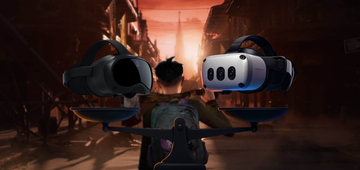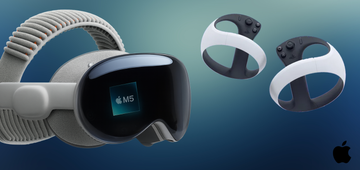What is the Difference Between a Standalone VR Headset and a PCVR: Complete Guide 2025
by Mariam Mdoreuli on Jul 25, 2025
Virtual reality has revolutionized the way we interact with digital content. But with the growing offerings, one question constantly arises: what's the difference between a standalone VR headset and a PCVR ? This fundamental distinction determines not only your experience, but also your investment.
In 2025, the VR market will offer two distinct approaches. On the one hand, standalone VR headsets offer freedom and simplicity. On the other, PCVR headsets promise performance and maximum immersion. Each technology meets specific needs.
What is a Standalone VR Headset?
A standalone VR headset integrates all the necessary components directly into the device. No external computer is required: processor, graphics card, battery, everything is there. This approach revolutionizes the accessibility of virtual reality .
Main features of standalone helmets
Standalone VR headsets operate like giant smartphones. They feature a dedicated operating system, usually based on Android. Computing power remains limited by size and battery constraints.
The main advantage? Total mobility . You can use your headset anywhere, without cables or complex setup. It's the ideal option for getting started in virtual reality .
What is a PCVR Headset?
A PCVR headset requires a connection to a powerful computer. The latter handles all the graphics calculations and sends the image to the headset via cable or wireless connection. This architecture allows you to harness the full power of your gaming PC.
PCVR Headset Architecture
PCVR headsets are simply high-resolution displays with motion sensors. All the power comes from your computer. This approach allows for exceptional graphics performance.
However, this setup requires a VR-ready PC with a dedicated graphics card. The initial investment is therefore higher, but the possibilities are endless.
Detailed Technical Comparison
| Criteria | Autonomous VR | PCVR |
|---|---|---|
| Processor | Mobile (Snapdragon) | Desktop PC (Intel/AMD) |
| Memory | 8-16 GB | 16-32 GB+ |
| Storage | 128-512 GB | Unlimited |
| Resolution | 2880x1700 | 4320x2160+ |
| Refresh rate | 72-120 Hz | 90-165 Hz |
| Weight | 500-600g | 400-800g |

This technical difference explains why “ what is the difference between a standalone VR headset and a PCVR remains a crucial question for any buyer.
Performance and Graphics Quality
PCVR headsets are the dominant force in terms of graphics quality. Connected to computers with powerful cards like the RTX 4080 SUPER , they can display ultra-detailed textures and stunning visual effects.
Graphical rendering of standalone headsets
Standalone VR headsets compensate for their limitations through optimization. Developers adapt their games to the hardware constraints. The result? Visually satisfying, if less impressive, experiences.
For the standalone VR headsets in our range, the emphasis is on fluidity rather than graphic detail. This approach ensures a nausea-free experience.
Discover our selection of standalone VR headsets now
Raw Power of PCVR Headsets
With a PCVR headset , you can access the most demanding games. Half-Life: Alyx in ultra, Microsoft Flight Simulator VR, the possibilities are endless.
Access unlimited virtual reality with our premium Varjo XR-4 PCVR headset
Mobility and Ease of Use
Mobility is the key advantage of standalone VR headsets . Unbox, turn on, play. In just a few minutes, you're immersed without any complex technical setup.
Simplified installation of standalone headsets
Installing a standalone VR headset is as simple as creating an account and defining your gaming area. No drivers to install, no compatibility checks to make. It's the ultimate consumer-friendly approach.
This simplicity explains why standalone headsets appeal to new virtual reality users.
PCVR System Requirements
A PCVR headset requires a compatible PC, with USB 3.0 ports, DisplayPort , and often external sensors. Initial setup can take several hours depending on your setup. However, this complexity is justified by the performance achieved.
Price and Value for Money
Budget directly influences your choice between a standalone VR headset and PCVR . Let's analyze the total investment required.
Entry cost of standalone headsets
A quality standalone VR headset costs between € 439.99 (for a Meta Quest 3S ) and € 1499.99 (for an HTC VIVE Focus Vision ). No additional purchases are necessary. You can get started immediately with a controlled budget.
Complete PCVR investment
For a complete PCVR setup, count on:
- PCVR headset: €400 to €1,200
- VR-ready PC: €1000 to €3000
- Accessories: €100 to €300
The total investment can reach €4,000 for a high-end configuration.
Games Library and Content
The content library varies significantly between the two technologies, with each platform developing its own specific ecosystem.
Autonomous helmet ecosystem
Standalone VR headsets primarily access dedicated stores (Meta Store, Pico Store). The catalog includes several hundred titles optimized for mobile, according to Meta.
Preferred genres: fitness, social, puzzle, and light adventure. The quality is constantly improving, with some remarkable exclusives.
Richness of PCVR content
Steam VR offers over 6,000 PCVR experiences. From indie to AAA, every genre is represented. This diversity makes it worth the investment for enthusiasts.
System Requirements
Understanding the technical requirements helps in choosing between standalone VR headset and PCVR .
Technical simplicity of the autonomous
A standalone VR headset requires only a smartphone for initial setup. A minimum 2x2 meter play area and a stable Wi-Fi connection are all you need.
This simplicity democratizes virtual reality among the general public.
PC Specifications for PCVR
A VR-ready PC requires:
- CPU: Intel i5-8400 / AMD Ryzen 5 2600 minimum
- GPU: GTX 1660 / RX 580 minimum (RTX 3070+ recommended)
- RAM: 16 GB DDR4
- Ports: USB 3.0 x3, DisplayPort 1.2+
User Experience
The user experience differs radically depending on your technology choice.
Comfort of standalone helmets
Modern standalone VR headsets feature adjustable straps and optimized weight distribution. 2-3 hour sessions remain comfortable for most users.
The absence of cables prevents any risk of tangling. You can move freely around your play space.
Maximum PCVR immersion
A PCVR headset offers a wider field of view and higher resolution. Immersion is maximized, especially in AAA games. Cables can limit movement, but wireless solutions are emerging.
Future Evolution of Technologies
The future of virtual reality is moving towards a gradual convergence between autonomy and performance.
Trends 2025-2027
Standalone VR headsets are incorporating ever more powerful chips.Qualcomm announces that its Snapdragon XR2 Gen 2 and XR2+ Gen 2 chips deliver up to 2.5x the GPU power , 20% higher CPU frequencies, and support for 4K resolutions at 90Hz, which is a significant step towards the visual quality of PCVR headsets.
At the same time, PCVR headsets are developing high-performance wireless solutions. The line between the two approaches is gradually blurring.
Which Helmet Should You Choose According to Your Needs?
Your choice depends on your personal priorities and your available budget.
Standalone headset user profile
Choose a standalone VR headset if:
- Limited budget (less than €1,000 total)
- Occasional use
- Significant mobility
- Simplicity sought
- First VR purchase
PCVR User Profile
Choose a PCVR headset if:
- Maximum performance required
- Gaming PC already available
- Heavy use
- Passionate about technology
- Existing Steam Library
Frequently Asked Questions (FAQ)
Can you connect a standalone VR headset to a PC?
Some standalone VR headsets offer PC connectivity via cable or Wi-Fi. This feature turns your standalone headset into a temporary PCVR headset . The quality remains lower than that of dedicated headsets, but it's a worthwhile option.
How long does a standalone VR headset last?
A standalone VR headset typically lasts 2 to 4 hours of battery life , depending on usage. Power-hungry games reduce this battery life. External batteries can extend playtime up to 8 hours.
Do PCVR headsets work with all PCs?
No, a PCVR headset requires minimal configuration. Your PC must have a dedicated graphics card and the appropriate ports. You can check your PC's performance with " The SteamVR Performance Test ."
Can you play the same games on both standalone and PCVR headsets?
Some games offer versions optimized for each platform. However, PCVR games generally leverage more advanced graphics. Standalone titles prioritize optimization and fluidity.
Which headset offers the best comfort for long sessions?
Comfort depends on each user's body shape. Recent standalone VR headsets incorporate counterweights to balance the weight. PCVR headsets often offer more sophisticated adjustment systems.
Are standalone VR headsets evolving as fast as smartphones?
Evolution is slower than that of smartphones, but constant. Manufacturers release new generations every 2-3 years. Software updates regularly improve performance.
Conclusion
What is the difference between a standalone VR headset and a PCVR? This question now has its complete answer. Standalone VR headsets prioritize simplicity, mobility, and accessibility. PCVR headsets maximize performance, graphic quality, and possibilities.
Your choice depends on your priorities: accessible discovery or premium experience. Both technologies are rapidly evolving toward a promising future convergence.
Check out our guide to choosing the right helmet for your needs





